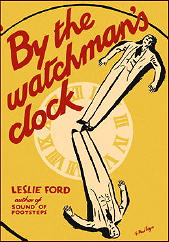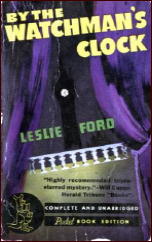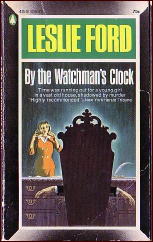Tue 12 Jun 2012
LESLIE FORD – By the Watchman’s Clock. Farrar & Rinehart, hardcover, 1932. Pocket #33, paperback; 1st printing, 1940. Popular Library 50-440, paperback, 1960.

I ended my previous review, that of Susan Moody’s Penny Dreadful [reviewed here ], with a quote. Let me start this one with another one, this one taken from the book’s first couple of paragraphs:
As a matter of fact, to give credit where credit is due, Daniel Sutton has done more for himself than Landover College has done for itself.

As a prologue, it sets the stage for the rest of the book in exact, precise fashion. In fact, if I were to tell you who the murder victim is to be, I don’t think that there is any way in the world that you would be surprised. With its old-fashioned, Southern aristocratic background, you could easily imagine, I’m sure, that there would be very few similarities between this book and the one with Penny Wanawake (modern, British, young, tall, black) as its leading character.
But you might be wrong if you did, and I’ll get back to that in a minute. One way that times have changed, though, is that the heroine who narrates Leslie Ford’s story, Martha Niles, a wife of one of the college’s professors, simply takes for granted the role that blacks have in the world. She would be utterly amazed at the possibility of a series of mysteries solved by a stunningly beautiful young black woman. To her credit, she seems intelligent enough that maybe it wouldn’t surprise her, after all. On the other hand, “black” is certainly not the word she ever uses. Other characters use worse.

The mystery in this book is cluttered by all sorts of “if I had only known”s, failures to follow through on even the most obvious hints and clues — when the murder occurs there seems to be absolutely no understanding that a fatal shooting is a matter for the police, and that no one should wander off right afterward — and silence on the part of many to protect someone else is seldom a good idea.
One similarity between this book and the previous one is the failure in each to bring the killer to conventional justice. The omission is even greater in this book, because I don’t believe the victim is as despicable as the one in Susan Moody’s book.
Daniel Sutton’s “crime” is only that he is rich, and the money he is hoarding could be used for better purposes. Although Martha Niles is one of the few people who actually likes him, even she seems to be content with the way the book ends.
I enjoyed the first 28 chapters, but the key to how well you like a mystery novel lies in the 29th chapter, not the first 28. It’s too bad. Given the time, the place and the era, the characters are described well, and they behave according. The book couldn’t be reprinted, but as a slice of an earlier America, it is, in its way, even better than the mystery.
May 1991 (slightly revised).
June 12th, 2012 at 6:29 pm
The book couldn’t be reprinted ?
Why, with the wave of reprints of Classics right now ?
The Doc
June 12th, 2012 at 7:45 pm
I was trying to be subtle, Doc.
June 12th, 2012 at 8:37 pm
Aaa.. I’m thick in the head, sorry- it didn’t sound such a bad book in your review.
The Doc
June 12th, 2012 at 8:50 pm
In that last paragraph I did my best to choose my words well.
Continuing on later…
Unfortunately I remember very few details about the book other than what I wrote about it then, over 20 years ago. I think it’s clear that as a mystery novel, I was disappointed in the ending.
As for the time, the era and the setting, that’s another matter. I don’t believe in censorship, nor do I believe in covering up aspects of the past that we regret now. The book is not likely to be reprinted, which is probably a good thing, but neither should we forget what history books don’t always tell us; that is to say, what life was like and how it was lived before we were even around.
Books like this one are artifacts, relics of its era, and living records of our past, and banning them is not the answer either.
What I wonder, and what I do not know, is whether the paperback edition that came out in 1960 was altered in any way.